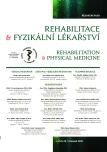Assessment of Sensory Processing Disorders in Children
Authors:
V. Husovská 1; P. Dvořáková 2; O. Švestková 1
Authors‘ workplace:
Klinika rehabilitačního lékařství 1 LF UK a VFN v Praze
1; Klinika rehabilitace a tělovýchovného lékařství 2. LF UK a FN Motol, Praha, přednostka kliniky doc. MUDr. O. Švestková, Ph. D.
2
Published in:
Rehabil. fyz. Lék., 25, 2018, No. 4, pp. 148-151.
Category:
Original Papers
Overview
Disorders in sensory processing signify that incoming sensory information is not translated into adequate responses. These disorders disturb the activities of everyday life of the child in the home and school environment. Unusual reactions to incoming sensory stimuli are also projected into behavior, attention, emotions as well as to motor skills and organization. It is therefore important to diagnoses these disorders correctly. A standardized test or standardized questionnaire are used for evaluation of sensory disorders (5).
KEYWORDS
standardized assessment, sensory profile 2, sensory processing disorders, sensory integration, ergotherapy in pediatrics
Sources
1. Breakthrough Study RevealsBiological Basis for Sensory Processing Disorders in Kids. University ofCalifornia San Francisco [online]. California, 2017 [cit.2017-09-27]. Dostupné z: https://www.ucsf.edu/news/2013/07/107316/breakthrough-study-reveals-biological-basis-sensory-processing-disorders-kidsi.
2. BROWN, N. B., DUNN, W.: Relationship between context and Sensory Processing in children with Autism. Američan Journal of Occupational Therapy [online], 64, 2010, 3, s. 474-483 [cit. 2018-04-21]. DOI: 10.5014/ajot.2010.09077. ISSN 0272-9490. Dostupné z: http://ajot.aota.org/Article.aspx?doi=10.5014/ajot.2010.09077.
3. DOREIT, S. B., MILLER, L. J.: No longer a secret: uniquecommonsensestrategiesforchildrenwith sensory or motor challenges. Arlington, Tex: Sensory World, 2011. ISBN 9781935567295.
4. DUNN, W.: Sensory Profile 2: User´smanual. USA, Pearson, PsychCorp, 2014.
5. KRANOWITZ, C. S.: Theout-of-syncchild: recognizing and copingwith sensory processing disorder. Rev. and updateded. New York, Skylight Press Book/A Perigee Book, 2005. ISBN 0-399-53165-3.
6. KRIVOŠÍKOVÁ, M.: Úvod do ergoterapie. Praha, Grada, 2011, ISBN 978-80-247-2699-1.
7. LANE, S., BUNDY, A. C.: Kidscanbekids: a child hood occupation sapproach. Philadelphia, F.A. Davis Co., c2012. ISBN 978-0-8036-1228-0.
8. MILLER, L. et al.: ConceptEvolution in sensory integration: A proposed nosology for diagnosis. Američan Journal of Occupational Therapy [online], 2007a, 61(2), 135-140 [cit. 2018-04-20]. DOI: 10.5014/ajot.61.2.135. ISSN 0272-9490. Dostupné z: http://ajot.aota.org/Article.aspx?doi=10.5014/ajot.61.2.135.
9. REYNOLDS, S. et al.: Using a multifaceted approach to working with children who have differences in sensory processing and integration. Američan Journal of Occupational Therapy [online], 2017, 71(2), 7102360010p1 - [cit. 2018-04-21]. DOI: 10.5014/ajot.2017.019281. ISSN 0272-9490.
10. Understanding Sensory Processing Disorder. STAR Institute for sensory processing disorders [online]. Quebec, 2017 [cit.2018-04-20]. Dostupné z:https://www.spdstar.org/basic/understanding-sensory-processing-disorder research. In: Star Institute: for Sensory Processing Disorders [online]. Quebec [cit. 2018-04-28]. Dostupné z: https://www.spdstar.org/landing-page/research
Labels
Physiotherapist, university degree Rehabilitation Sports medicineArticle was published in
Rehabilitation & Physical Medicine

2018 Issue 4
- Hope Awakens with Early Diagnosis of Parkinson's Disease Based on Skin Odor
- Deep stimulation of the globus pallidus improved clinical symptoms in a patient with refractory parkinsonism and genetic mutation
Most read in this issue
- Mirror Therapy and Its Application in Neurorehabilitation
- Assessment of Sensory Processing Disorders in Children
- Influence of Breathing on Activity of Pelvic Floor Muscles in Relation to Body Position
- Physiotherapy – a Modern and Dynamic Banch
